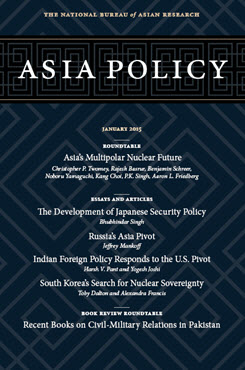The India-Pakistan Nuclear Dyad and Regional Nuclear Dynamics
This is one of seven essays in the roundtable “Approaching Critical Mass: Asia’s Multipolar Nuclear Future.”
P.K. Singh is Director of the United Service Institution of India in New Delhi. He retired from the Indian Army as an Army Commander in 2008.
This is one of seven essays in the roundtable Approaching Critical Mass: Asia’s Multipolar Nuclear Future.
Nuclear weapons in various stages—in established armories, latent capacity, or merely embryonic potential—are alive, well, and thriving in Asia. Ashley Tellis has very aptly written that “given the contested geopolitics of Asia, which is defined by several enduring rivalries, many unresolved territorial disputes, significant local power transitions, and now the continent-wide anxieties provoked by the rise of China, it is not surprising that nuclear weapons have retained their critical importance.” [1] To put the South Asian dimension of the nuclear environment in its correct perspective, it is critical to view the disputes, rivalries, and players involved in a historical and regional context. This essay begins with a brief historical overview of the regional dimension of India-Pakistan nuclear dynamics and then looks more specifically at the perspectives and nuclear policies of India and Pakistan, as well as on China’s nuclear policy vis-à-vis India. Finally, the essay concludes by asserting that the India-Pakistan nuclear dyad must be understood within the context of broader nuclear dynamics in the Asia-Pacific region.
The Regional Dimension of India-Pakistan Nuclear Dynamics
Before 1947 the Indian subcontinent was surrounded by the buffer states of Afghanistan, Tibet, and Burma, and the external players in the region were Britain and Russia. Soon after independence, Pakistan fought a war with India and occupied a part of Jammu and Kashmir. Pakistan later joined the Southeast Asia Treaty Organization (SEATO) and the Central Treaty Organization (CENTO), bringing the United States and its alliances into the subcontinent in an effort to resist the influence of the Soviet Union. Tibet was taken over by China in the 1950s, introducing China as an important actor in the South Asian geopolitical and strategic environment.
Endnotes
[1] Ashley J. Tellis, “No Escape: Managing the Enduring Reality of Nuclear Weapons,” in Strategic Asia 2013–14: Asia in the Second Nuclear Age, ed. Ashley J. Tellis, Abraham M. Denmark, and Travis Tanner (Seattle: National Bureau of Asian Research, 2013), 14.
About Asia Policy
Asia Policy is a peer-reviewed scholarly journal presenting policy-relevant academic research on the Asia-Pacific that draws clear and concise conclusions useful to today’s policymakers. Asia Policy is published quarterly in January, April, July, and October and accepts submissions on a rolling basis. Learn more


